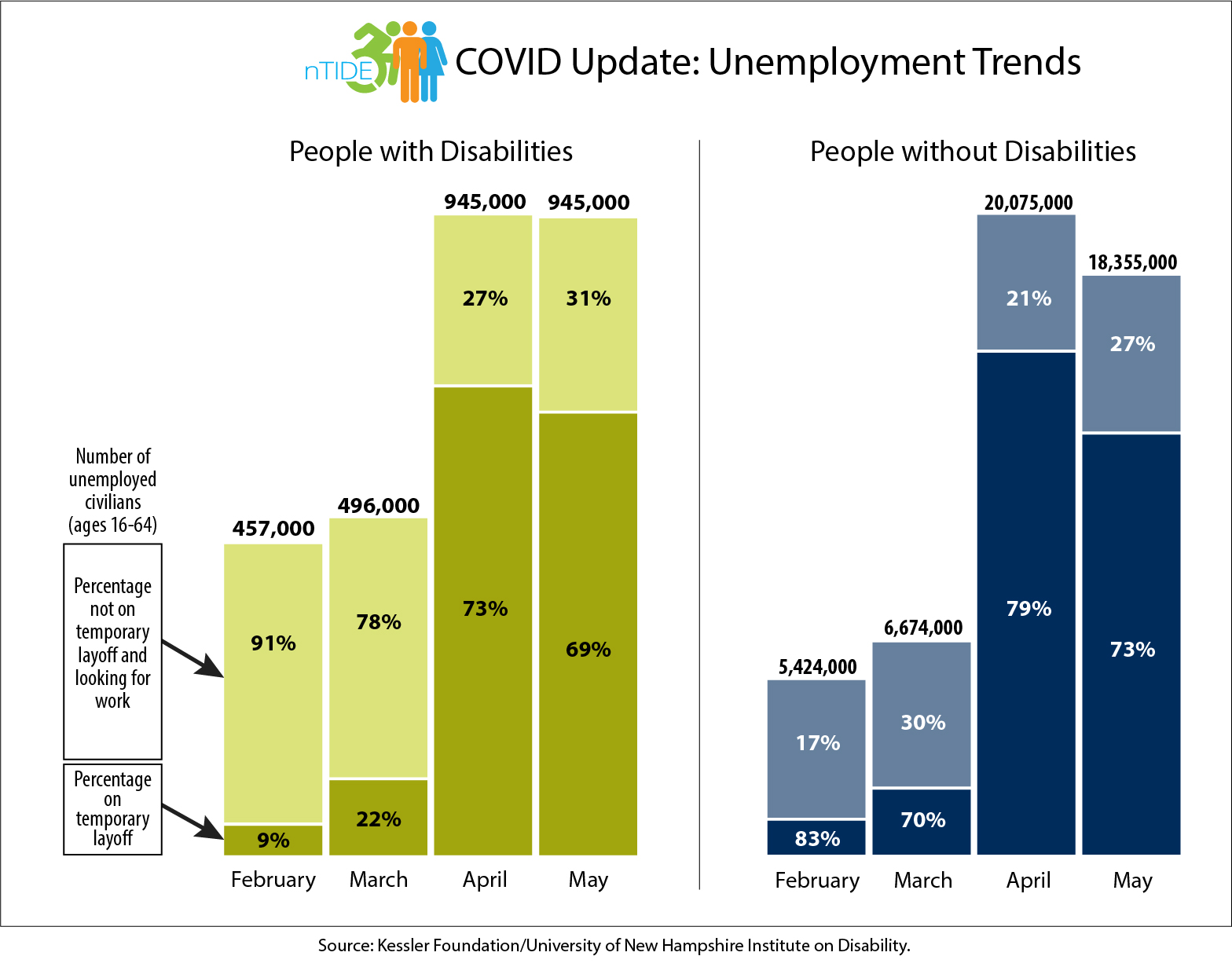nTIDE June 2020 COVID Update: Numbers Improve for Workers With and Without Disabilities

Kessler Foundation and University of New Hampshire nTIDE COVID Update—featuring economist Andrew Houtenville, PhD, and disability employment expert John O’Neill, PhD, with an extended analyses of the May job numbers
East Hanover, NJ – June 24, 2020 –The COVID economy continues in a state of flux, causing ongoing challenges for all workers, with and without disabilities, according to May’s National Trends in Disability Employment (nTIDE) COVID Update, issued by Kessler Foundation and the University of New Hampshire’s Institute on Disability (UNH-IOD). There was improvement in the job numbers for workers with and without disabilities as states began phased reopenings of businesses, public spaces, and nonessential services.
As reported in the May Jobs Report, the labor force participation rates and employment-to-population ratios for people with and without disabilities were up slightly from the dramatic lows of April. From April to May, the number of employed working-age people with disabilities increased by 212,000 (from 3,827,000 to 4,039,000), a 5.5% increase, while the number of employed working-age people without disabilities increased by 3.2% (from 120,804,000 to 124,654,000). [Note: these estimates compare the reference weeks of the underlying survey April 12-18 and May 10-16.]
The historic levels of unemployment in April carried over into May, remaining at 945,000 for people with disabilities, and declining from 20,075,000 to 18,355,000 for people without disabilities. The large majority of workers were still on temporary layoff (a.k.a., furloughed). However, the percentage of temporary layoffs declined for both groups, which may indicate some were called to return to their jobs, or were permanently laid off.
Of the 945,000 unemployed working-age people with disabilities in May, 68.9% were on temporary layoff, down from 72.6% in April. Of the 18,355,000 unemployed people without disabilities, 72.5% were on temporary layoff down from 79.0% in April. This statistic far exceeds the previous high for temporary layoffs of 28.1%, a level reached in February 1975, for persons ages 16 and older, during the 1973-1975 Oil Crisis/Stagflation Recession (Bureau of Labor Statistics, time series LNU03023654). The percentage of people actively looking for work increased in both groups from April to May – from 27.1% to 31.1% for people with disabilities, and from 21.0% to 27.5% for people without disabilities.
“To see sustained improvement, people with disabilities need to remain engaged in the labor market,” said economist Andrew Houtenville, PhD, research director of the University of New Hampshire’s Institute on Disability, “by continuing to work, returning to work after being furloughed, and striving for new opportunities in the COVID economy. This will depend on the strength of economic activity as the nation adapts to the ongoing pandemic. We may see new waves of layoffs as businesses cope with the changing economy, and more job losses as some employers are unable to overcome the setbacks,” he cautioned. “We want to see the unemployment go down, but not because people are dropping out of the labor force. That would threaten decades of progress for workers with disabilities.”
“For many people with disabilities, staying engaged in the labor market depends on many factors,” noted John O’Neill, PhD, director of employment and disability research at Kessler Foundation. “In addition to the immediate needs to support remote work and provide personal protective equipment (PPE), we need to look at retraining job coaches and revamping vocational rehabilitation services for identifying the new jobs created by the COVID economy.”
As the COVID-19 pandemic continues to affect the national and global economies, staying engaged in the labor market is a priority for all workers. The nTIDE team will continue to follow the trends for workers with and without disabilities as they adapt to the fluctuating American labor market. We will continue to offer this monthly nTIDE COVID Update, in addition to our usual Jobs Friday nTIDE, to provide stakeholders in disability employment with the information they need to help individuals and service providers meet the challenges of the COVID economy. Register now for our Thursday, July 2 nTIDE, for our experts’ initial view of the June numbers.
nTIDE Lunch & Learn
View the special recorded episode of the nTIDE Lunch & Learn series, which was broadcast June 19th. This episode, hosted via Zoom Webinar, offered attendees Q&A on these findings. Dr. O’Neill, Dr. Houtenville, and Denise Rozell, described these findings and their implications for people with disabilities and the public and private agencies that provide employment services. The recording may be found at ResearchonDisability.org/nTIDE.
NOTE: The statistics presented are generated from the same data sources as the Monthly nTIDE Jobs Report, which is the same source for the official US unemployment rate—the Current Population Survey (CPS). The statistics may differ slightly from the Monthly nTIDE Jobs Report and official statistics released by the US Bureau of Labor Statistics, because they are based on data from the CPS public-release microdata files. nTIDE and this Special Report are funded, in part, by grants from the National Institute on Disability, Independent Living and Rehabilitation Research (NIDILRR) (90RT5037) and Kessler Foundation.
About Kessler Foundation
Kessler Foundation, a major nonprofit organization in the field of disability, is a global leader in rehabilitation research that seeks to improve cognition, mobility, and long-term outcomes -- including employment -- for people with neurological disabilities caused by diseases and injuries of the brain and spinal cord. Kessler Foundation leads the nation in funding innovative programs that expand opportunities for employment for people with disabilities. For more information, visit KesslerFoundation.org.
About the Institute on Disability at the University of New Hampshire
The Institute on Disability (IOD) at the University of New Hampshire (UNH) was established in 1987 to provide a coherent university-based focus for the improvement of knowledge, policies, and practices related to the lives of persons with disabilities and their families. For information on the NIDILRR-funded Employment Policy and Measurement Rehabilitation Research and Training Center, visit ResearchonDisability.org.
For more information, or to interview an expert, contact:
Carolann Murphy, 973.324.8382, [email protected].